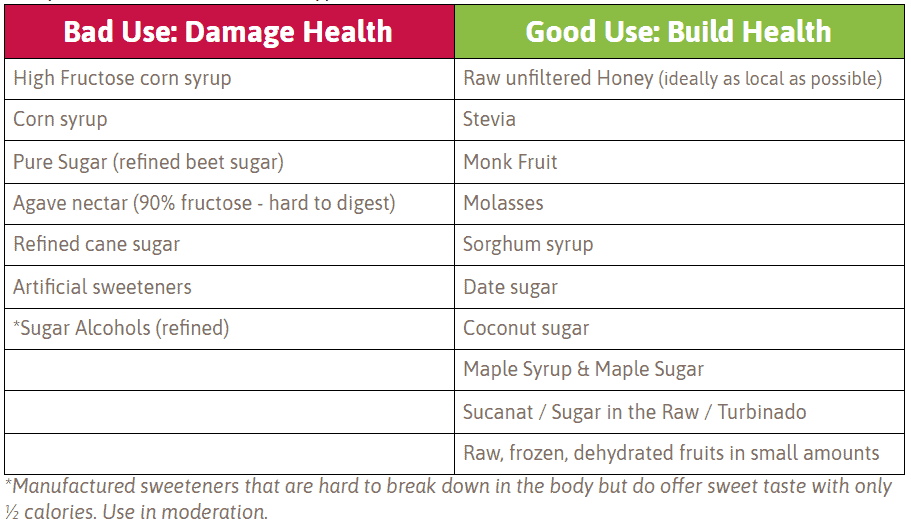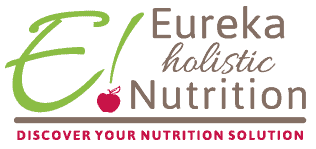
Using sugar as a tool for building health means one word… BALANCE. That balance depends on two factors: TYPE and AMOUNT. Sweeteners of all kinds have been a part of our diets since the beginning of time, but no one can argue that it’s the types and amounts have increased and changed significantly in the last 100+ years! By returning to these whole, nutrient dense sugars in small amounts, on special occasions, sugars can once again be a piece of building health vs. tearing it down. When replacing refined sugars with real, whole ones allows your body to naturally utilize and bring back into balance our main energy source. However, the balance part of the equation could look different for each person.
What TYPES of sugars are whole and nutrient dense?
When natural sugars contain all the nutrients that help our body utilize the sugar properly… that’s a nutrient dense, beneficial sweetener. Nutrients that help our bodies metabolize sugar and use it effectively are:
- Magnesium
- Chromium
- B Vitamins
- Enzymes
- Fiber
Notice how many of the natural sweeteners listed in the Good Use side also contain these supporting nutrients!

Here’s a quick nutrient list for some of these natural sweeteners:
RAW HONEY: Antioxidants. Enzymes. Trace amounts of vitamins like thiamin and niacin
MOLASSES: Magnesium. Copper. Potassium. B Vitamins.
SORGHUM SYRUP: Manganese. Vit. B6. Magnesium. Riboflavin (Vit. B2). Potassium.
MAPLE SUGAR / MAPLE SYRUP: (organic unfiltered,Grade B contains the most nutrients) Zinc. Manganese. Calcium. Iron. Magnesium.
How about AMOUNTS?
Let’s answer that question in three ways:
#1: Grams of sugar per serving – Goal is to stay below 10g sugar per serving. But this number could look a bit higher when averaged out over the entire day( #2). Meaning one food item may have more than 10g per serving, but the amount of servings still falls within the total #2 Servings per day Goal amount.
Consider this typical breakfast:
Bowl of Honey Nut Cheerios – 9g
1 Banana – 14g
8 oz Orange Juice – 24g
1 cup Skim Milk – 12g
TOTAL sugar intake – 59grams!!
If we start our day with this type of breakfast it’s no surprise we experience negative moods, irregular energy, afternoon crashes and food cravings!
#2: Servings of sugar per day – Goal is to stay below 25-30g per day for the average adult person who is not overly active.
#3: Added sugars – What does “added” mean? Simply any sugar not naturally occurring in a food, but has been added in the process of manufacturing that food. Using our typical breakfast example, the only added sugar would be the 9grams from the Honey Nut Cheerios. Every other sugar (fructose from banana and orange juice and lactose from milk) is naturally occurring. The Dietary Guideline here in the US recommends no more than 30 grams of ADDED sugar per day. They make a distinction between natural and added. While there is more health damage caused by these refined, processed, added sugars; it’s so important to note that even naturally occurring sugars in high amounts (especially fructose) can cause the same long list of undesired negative effects of inflammation, weight gain, metabolic syndrome, mood disorders, hormone imbalance, etc.!! Although the natural occurring sugars also come with other nutrients that help slow absorption and support the body’s metabolic processes, so they are preferred for that reason, but still in moderation. Instead we have included BOTH in the 25-30g per day total.
What does sugar BALANCE look like?
Here’s a glimpse at the process of developing a disease state related to blood sugar imbalances. Following the 10 Steps outlined below (or even just 5 of the 10) will go a long way in getting off the path to diabetes (Type II).
10 STEPS to BALANCE BLOOD SUGAR:
Step 1: Replace processed sugars for whole, nutrient dense sweetener options
Step 2: Limit fruits to low glycemic (citrus, berries, pears) 2 servings per day
Step 3: Eat serving of fat or protein with your fruit (apple with nut butter, greek yogurt with berries)
Step 4: Stay hydrated (½ body weight in ounces of per water a day)
Step 5: Start your day with healthy proteins and fats at breakfast
Step 6: Exercise moderately 20-30 min a day
Step 7: Check for food sensitivities. Foods we are sensitive to can elevate insulin and cause sugar imbalances.
Step 8: Eat probiotic rich foods (plain dairy kefir, plain yogurt, cultured veggies, kombucha – check sugar, cultured cottage cheese, cultured sour cream). Take a Probiotic Supplement – broad spectrum (at least 10 strains), high count 20 billion or more 2x a day.
Step 9: Try Intermittent Fasting model (14:10 is a good one to start with) KEY: eat often (every 2-3 hours during your feeding window.
Step 10: Register for our 14 Day Sugar Detox Program as a part of our GET STARTED PACKAGE!!
